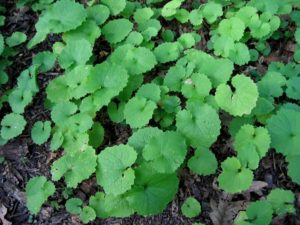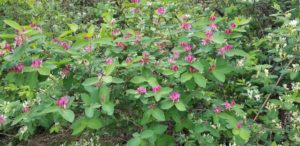By Paul Cigan, plant pest and disease specialist, Paul.Cigan@wisconsin.gov, 715-416-4920
One of the most amazing aspects of living in Wisconsin, with its four seasons of ever-changing natural beauty, is the re-awakening of plant life every spring. Whether you’re a gardener, sportsperson or casual observer on a walk, it’s hard to overlook the floral sea of white trilliums, the bee-frenzied blooms of a crabapple, or even the mere greening up of turf grass. These spring advances usher in a sense of re-awakening of a sleepy plant world and assure us that summer will once again come.
While recently out on a spring hike in northern Wisconsin, my eyes were drawn to the bright green glow of emerging understory plants. Making my way closer, my initial excitement was offset by the disappointment of seeing what I quickly realized was in fact garlic mustard—an increasingly common and problematic exotic, invasive understory plant. Although garlic mustard is perhaps the “poster” plant for invasive plant awareness, the unfortunate reality is that it is just one of hundreds of invasive species that continue to spread into our forests.

The spring green-up of garlic mustard may look pretty but this invasive species is not good news for Wisconsin forests or the people who manage them. Credit: Duluth CISMA.
According to Wisconsin’s Statewide Forest Action Plan, surveys show that invasives are expanding their reach into new areas, threatening native vegetative communities and challenging forest management in the process. With wide-ranging adaptive advantages such as rapid growth rates, prolific seed production, and a lack of natural predators, invasives can quickly reduce native plant diversity and tree regeneration. Invasives may limit light, nutrients and water, making it more difficult for native vegetation, including tree seedings, to establish and survive. In some heavily invaded forest stands, control measures are needed to allow oak, pine, maple and many other economically and ecologically critical tree species to regenerate.
There is an arsenal of techniques available to manage invasives, ranging from chemical, mechanical and biological controls to prescribed fire or any combination therein. In some cases, these techniques prove successful at limiting the establishment and spread of unwanted invasives. But there are other cases, particularly where invaders are detected late or allowed to grow over multiple years and become established, where invasive species leave behind a long-lasting legacy in the form of prolific seed banks. Invasive honeysuckles for example continue to sprout for years after plant removal. In these cases, follow-up treatments and close monitoring is required for successful control. No matter the ease or required frequency of any control measure, however, the result is added costs and heightened barriers to sustainable forest management.

Honeysuckle is a notoriously difficult species to control because of its re-sprouting ability. Management often requires repeated follow-up control efforts over multiple years. Credit: Duluth CISMA.
Preventing invasive species’ spread and establishment is the preferred approach rather than controlling them after they become established. For that reason, the Wisconsin DNR invests in prevention efforts such as education, outreach and policy development based in strong partnerships. Working closely with the state’s nursery industry and other partners involved in the commercial plant trade, the DNR has created a multipronged regulatory policy called Invasive Species Rule – NR 40. The goal of NR 40 is to prevent new invasive species from arriving and establishing in the state by systematically classifying each species, establishing a regulatory framework for responsive eradication and control measures, and focusing educational efforts toward the general public and affected stakeholders. In addition, educational partnership between the DNR and key industry groups, such as the Forest Industry and Safety Alliance (FISTA), has significantly broadened the reach of invasive plant education and awareness. Each spring and summer, FISTA hosts educational day courses led by DNR staff specialists. Forest industry professionals, some of whom spend perhaps the most time in the forest of any group, gain a first-time look or periodic refresher on the identification, biology and best management practices to prevent and minimize the spread of invasives.
These efforts are just a couple of examples in which the DNR strives to be a statewide leader in its commitment to maintain and even gain back some ground on invasives. But the truth is, it is not really our foothold that we stand to keep as much as it is a “roothold”— for the many native species, including oaks, pines, hickories, and trilliums – that keeps the canopy productive, understory unique, and our eyes twinkling with interest as we gaze upon our treasured Wisconsin forests this spring.
#NASF100
